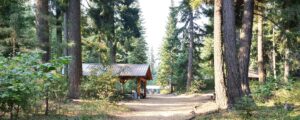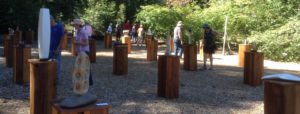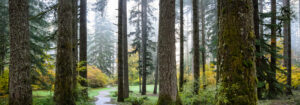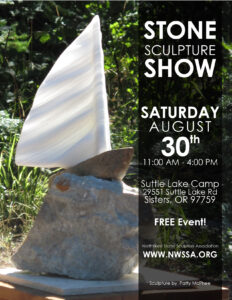
Home » NWSSA Events » Stone Carving Symposia » Oregon Stone Carving Symposium at Suttle Lake » Nugget News: Stone Sculptors Make Rock Solid Art, Friendships

For the Nugget News
By Helen Schmidling
Tuesday, August 20, 2019 1:00 PM
Turning a stone into a work of art is hard work. It’s dirty. It’s noisy. It can be toxic. And it’s addicting. Ask any one of the artists participating in the International Stone Carving Symposium this week at Suttle Lake Camp. The camp wrapped up with a big outdoor show of stone sculptures on Saturday.
Dozens of people roamed the site, running their hands over finished work, and barely resisting the temptation to touch sculptures-in-progress, in spite of the “Do Not Touch” signs. The sculptures, both real and abstract, were displayed atop rough wood pedestals; and as the morning sun rose higher in the sky, each reflected or refracted light in different directions. Such is the beauty of carved and polished stone.
Symposium Director Doug Wiltshire said that at any given time during the week, between 50 and 60 sculptors worked on their art, sponsored by the Northwest Stone Sculptors Association (NWSSA). They hailed from Washington and Oregon, from British Columbia, Italy, Germany, and Japan.
Some continued to work through the day on Saturday under individual open-air tents, chiseling, sanding, blasting, and sanding again. The tents circled a vast open field with a massive compressor at the center, air hoses snaking through the grass to the tents to power each sculptor’s tools. The hiss of the compressor alternated with the whir of drills and the chime of chisels. Early in the week, the sculptures were rough – barely suggesting a figure, an abstract shape, or a face. Saturday, the finished (or almost finished) work was displayed for the public.
The artists are both men and women, teens to seasoned citizens. Some worked the stones for the very first time, and others have 30 or more years of carving and the arthritic joints to prove it. Some have MFA degrees framed back on their studio walls, where they often work in solitude. The communal sculpture event in the woods at Suttle Lake draws them back year after year because it’s both nurturing and inspiring.
Jason Chrastina of Portland was lured back to carving after a long hiatus. Perched in front of his tent early on in the week were three moderately sized sculptures that he made around 20 years ago: one in marble, one in limestone, and one in alabaster.
“Life just got in the way,” he said.
He works in retail, selling natural foods and homeopathic medications to stores all over Oregon.
“Around 1999, I moved to Seattle,” he recalled. “I knew about this society; I knew there was something, somewhere, but this year, my partner found out about this (symposium) and encouraged me to do this. So I got this chunk of marble, drilled some holes in it, and I’m chiseling around the holes.”
On Saturday, Chrastina showed his early work alongside the almost-finished marble piece, which was pinned to a base of granite, the circular holes at the bottom and a series of parallel notches carved at the top. Half of one side was polished, the other half in its natural fractured state.
Jason beamed as he walked through the sculpture garden: “I’m definitely coming back next year,” he said.
Leon White from Seattle is a veteran. On his workbench, a mermaid emerged from a two-foot tall block of premium Carrara marble. White described the whimsical piece in great detail.
“She’ll have a sand dollar necklace, and she’ll be petting a sea horse. There will be a fish here, and a starfish under her tail, which will sweep around to the back like so,” he said, waving his hands over the marble.
A career artist, White began as a painter, but turned to carving stone when he got bored. He’s been a member of NWSSA since 1989, but this was his first symposium near Sisters.
White’s mermaid was still growing from her base on Saturday, but he displayed a humorous but stone-cold piece called “Dinner is Served,” consisting of a carved plate and full course: a pork chop, green beans, baked potatoes and a warm roll, complete with marble “butter pat.”
“You know, it doesn’t upset me if I don’t get a whole lot done this week,” White said. “I just bring one piece to work on, because this … it’s like a reunion. We’re all excited to be here. Many of these folks don’t have a studio where they can generate this much noise and dust, so they come here to rough things out and take them back home to finish.”
Stephanie Robison runs the sculpture program at City College of San Francisco. All week, she worked with beginning carvers who had the opportunity to try their skill using borrowed tools, borrowed air, and new materials. Baeven Hoit, 17, of Bainbridge Island, Washington, was one of them. Her mom, Valerie, explained that Baevin has tried out all kinds of art, and makes up stories about her art as she goes. Her first sculpture definitely looked like a wolf with a bird on its back. Baevin, who has autism, is one of many special-needs students participating in the symposium this year.
During the week, sculptor Patty McPhee of Tacoma polished a soft translucent calla lily with an onyx peduncle that she displayed on Saturday. She’s been with NWSSA for 25 years.
“It’s where I found my passion,” she said. “It’s hard work but it’s so soul-satisfying, because it connects you to the earth.
“We’re doing what we love, but it’s toxic,” she noted. “I mean, really toxic. Once I was sanding a piece, a green stone called chlorite, when my husband walked in and hollered ‘STOP!’ I looked around me and there was a green haze, everywhere.”
She has asthma as a result, but she won’t give up her passion.

McPhee is a self-described “tool junkie,” with at least three angle-grinders and more safety gear than a small store. All of it thanks to her teacher and mentor, Everett DuPen. In 1925, the Hollywood Daily Citizen praised the then 13-year-old sculptor DuPen as “the genius among us.”
By his death at age 92, DuPen was an “elder” and fellow of the National Sculpture Society and National Academy of Design. In his 38-year faculty career at the University of Washington, he made the Sculpture Division a nationally and internationally known group. He was a friend and a mentor to generations of artists, including McPhee, White, and others within NWSSA, who are now mentors to a new generation entering the enchantment of this age-old art form.
“I mentor anyone who comes my way,” McPhee said, “and I find that I learn so much from the people I mentor. I receive far more than I give.”
One of her mentees at Suttle Lake was Jason Chrastina.
As Saturday wore on, the sculptors began to pack their gear and load their rigs for the long trek home. But they will be back next summer. It’s set in stone.





We need some kind of descriptive text here.